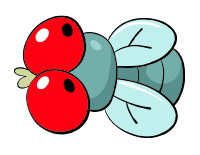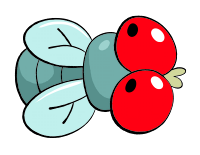FRIDAY THE 14th, DECEMBER 2018:
SNOW FLIES

Mike Lewinski
Most people are probably familiar with crane flies, the order Tipulidae. With their long bodies, long wings and even longer legs, they're often the "largest" looking of all true flies, and even scare the piss out of some people in the same way as even the most harmless spiders. They're even mistaken by some for "giant mosquitoes," though some also refer to them as "mosquito hawks" or "skeeter eaters" in the mistaken belief that they're carnivorous.

Stephen Luk
In truth, crane flies are among those insects who barely feed at all in adulthood, with nearly useless mouths and incomplete guts if either are even present at all. Instead, they spend most of their existence in their fairly large larval stage, which in many species is strictly aquatic. The "tentacles" on this one are part of its posterior breathing apparatus, and come in a wide array of weird shapes froms species to species. Some are even carnivorous, feeding on other insect larvae in mud or moist soil.
We're not here to just talk about regular crane flies, though! It's the dead of winter for a lot of the planet right now, which makes crane flies relevant for some pretty unique and interesting reasons.

Margarethe Brummermann
Insects aren't something we associate with colder climates, and most aren't very well adapted to them at all, as we talked about when we reviewed the bone skipper weeks back.
Several crane fly groups, however, can be found thriving in chilly, even frosty environments at high altitudes, like this Dactylolabis vestigipennis, and you'll notice that its wings are little more than useless nubs. The loss of flight is critical to its survival at low temperatures, because the act of flying expends significant amounts of heat and would either kill the spindly little insect in mid-air or limit flight time to the point of uselessness.

D. Sikes
Several crane fly groups include a few of these flightless cold-dwellers, but one genus, the "snow flies" or Chionea, lack even the most vestigial traces of wings.
Larval snow flies dwell beneath layers of rotting forest litter or even in the burrows of hibernating rodents, where they feed on feces, mold or algae and have no difficulty keeping warm. As adults, they keep from freezing by producing glycerol in their blood, but they still need to hold on to all the warmth they can, so the wings just had to go. Their shorter, fatter abdomens help conserve energy even more, and the space that once belonged to their wing muscles is used by the females to store extra eggs. They still, however, possess full halteres (see the first Flyday!) which probably still serve important sensory function.
As soon as they can, snow flies seek out the very coldest temperatures they can find, and are some of the world's only insects that comfortably live directly on ice and snow at below-freezing temperatures. They will live for only about two months, drinking water from the surface of snow but never feeding, and since they can't travel too far anyway, they don't bother with any sort of mating ritual or competition, pairing right up as soon as they meet a snow fly of the opposite sex.

K-State Research
Being one of the only insects you can find in a given climate presents some great advantages to Chionea, notably the lack of such predators as spiders, wasps, frogs, lizards and many small birds. On the downside, it means that the few exceptions must concentrate their attention on the relatively helpless snow flies, and they fall prey to foraging rodents just enough that they're a major host of rodent tapeworm.
Much more unusually, adult snow flies are often found with a translucent "ring" around their necks, packed full with the eggs of a nematode worm still not formally studied. It's believed that the adult worm secretes this ring as the insect emerges from its pupa, but we don't know much else about the worm's life cycle or feeding habits. We don't even know for sure if it's a parasite of the snow fly or merely uses them to spread its eggs.


